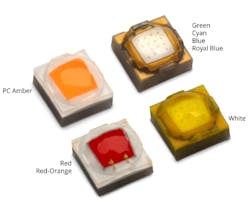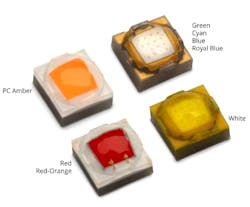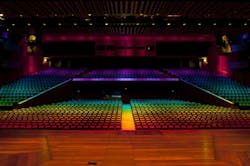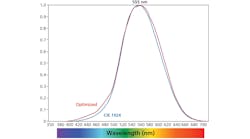Monochromatic and phosphor-converted color LEDs target applications such as emergency vehicle lighting and dynamic façade illumination with tight beam and consistent focal length.
Lumileds has brought the new Luxeon C family of monochromatic- and phosphor-converted-color LEDs to market, leveraging some of the latest epitaxial, packaging, and optics technologies from white high-power LEDs. The new family includes a low-profile primary dome-shaped optic for more center punch and the optic height is consistent relative to the emitting surface on all LEDs in the family for precise color mixing.
Interested in more articles & announcements on LEDs & sources?
The Luxeon C family includes 7 color LEDs plus white LEDs in five different CCTs at launch. By the end of the year, Lumileds said it will add five more color options along with a 90-CRI, 5700K-CCT white LED. The new family targets a broad range of applications with dynamic architectural lighting and emergency-vehicle lighting as prime examples.
The new announcement marks the second recent instance of Lumileds rolling out new color LEDs. In July, the company announced the Luxeon 3535L mid-power family. The new high-power LEDs target some of the same applications but with greater output and better optics are particularly suited for applications where beam control is paramount such as in studio lighting in addition to the previously mentioned usages.
David Cosenza, product manager for the Lumileds color LED product line, said the Luxeon C project was a near joint development effort with some top-tier customers. Moreover, he asserted that "consistent focal height and optical symmetry across all colors" was the top demand from the lead customers.
Indeed, phosphor-converted white, blue/green, red, and other-color LEDs have inherent differences in device architecture that would typically lead to different heights between the base of the LED and the top emitting surface. Lumileds engineers developed the new line so the so-called z-height is identical across all LEDs in the family and all of the products use the same low-dome design that is less than a full hemisphere.
When you mix LEDs with different heights and inconsistent primary optics, the result can be color halos. For example, there are many façade- and studio-lighting products that exhibit red halos. The undesirable effect is due both to the different focal length and different beam patterns. Cosenza said the new color LEDs will eliminate the halo effect.
The low profile optic also delivers more of the light from the emitter in the narrow beam for higher center beam candle power. Essentially, the size of the emitter is effectively smaller through the optic — a feature that Cree has touted in some white LEDs.
Cosenza said the LEDs will meet the most stringent beam-control demands and that product developers can design a single secondary optic such as a total internal reflection (TIR) lens or reflector for use with all of the available colors. According to Cosenza, some emergency vehicle lighting uses beams as narrow as 2°, and he said Luxeon C could be used in such designs with the proper secondary optics.
Lumileds will also become the first manufacturer to hot test and bin color LEDs at 85°C with the Luxeon C family. Such testing is critical to consistent performance at temperature both in terms of the wavelength shift of each emitter and in intensity shift. Lumileds (then Philips Lumileds) became the first manufacturer to hot test and bin white LEDs with an announcement at Strategies in Light 2011. Most competitors have since adopted the hot-testing strategy. Rahul Bammi, Lumileds vice president of marketing and product management, said he expected competitors to again follow suit.
Lumileds said it is already shipping the Luxeon C product to some lead customers. Initially, the 2×2-mm LEDs are available in red-orange, red, cyan, green, blue, royal blue, and phosphor-converted amber. Later Lumileds will add deep red, far red, and amber, along with phosphor-converted lime and mint.
Considering that color LEDs are still somewhat niche products relative to white LEDs, Lumileds is expecting significant success with the new family. Bammi said the introduction may be the company's "biggest launch of the year." The new color line is intended to replace the Rebel Color LEDs that have long been part of the Lumileds portfolio.








